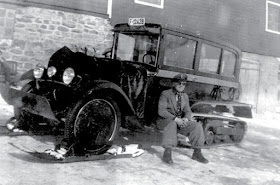Que voulez-vous : c’est la neige qui m’inspire…à moins que ce soit un T.O.C qui me poursuive : je voudrais bien me remettre à construire une autochenille. Et comme j’ai déjà réalisé des chenilles tout-terrain P17, je rêve de réaliser des chenilles plus adaptées à la neige : des P15 N. N comme neige évidemment ! Logiquement, Kégresse avait conservé la partie centrale plate, avec ses quatre rouleaux. Mais il avait complètement descendu l’essieu arrière afin qu’il adhère bien. Et descendu également l’essieu avant, le tout allongeant le train de manière substantielle pour améliorer le collage au sol quand celui-ci était gelé donc glissant. Ceci explique le garde-boues rallongé, et le plateau rajouté à l’arrière dans le torpédo, et la caisse également rallongée des petits autobus construits sur le châssis. Vous allez vous en rendre compte avec les nouvelles photos qui suivent.
Mon problème en effet : comment retrouver suffisamment de vues de modèles réels pour les reproduire avec précision ? Mon erreur depuis que durent mes recherches a été de me cantonner à la France. Donc en montagne : pas grand chose sauf dans les années 1910-1920, avec des B2, mais pas des C6 plus tardives. Je me suis ensuite polarisé sur la Suisse , et vous ai déjà montré de superbes réalisations. Et puis j’ai réfléchi : souvent les modèles rares ont été exportés, et se retrouvent mieux dans les pays d’importation que dans le pays de fabrication. J’avais survolé Norvège et Islande, et c’est là que sont les plus beaux modèles : préservés dans les musées comme celui de Skógar, et surtout présents dans d’anciens albums de photographies.
Consultant à nouveau le site danois http://kegresse.dk, je découvre qu’il s’est considérablement enrichi, et publie de nouvelles photographies qui vont me permettre de détailler des voitures déjà montrées, avec quelques détails supplémentaires sur les lieux et même les personnages.
Voici un copié-collé en anglais, très complet sur ces Citroën spéciales exportées en Norvège et Islande. Je commence à comprendre comment sont conçues les chenilles, et me prépare à créer un prototype. Après tout, c’est l’hiver, on ne peut pas faire grand chose dehors, c’est donc bien le moment !
The Citroën-Kegresse P15N was introduced in december 1928. The engine was the same as in the P19 Kegresse; the 6 cylinder engine from the Citroën C6 with a volume of 2442 cm3 and a 3-speed gearbox. In December 1932 the P15NK was presented. This car differed from the previus having a bigger engine (3015 cm3). In november 1934 the P15N 75 was presented, and now the new engine from the 15 Rosalie model was used. Still a 6 cylinder, but now with 2650 cm3 and a 4-speed gearbox. The Chassis weight increased through the period from 1600 to 1790 kg . The P15N series differs from the other Citroën-Kegresses as they were equipped and made for use in snow. They were fitted with skis by the front wheels and the belts were much wider and longer than the standard Kegresses. All wheels were dimentioned to these extra wide belts. The plates on the belts were moulded in aluminium alloy (to reduce the weight). At the centre of each of them was a rectangular rubber block which were arrower than the normal 6-sided blocks. When the P15 came to Iceland In 1929, the Icelandic Road Administration (ICERA) imported a half-track Citroën-Kegresse model P15N. A year later, they imported three more. As far as we know, all four vehicles were imported as rolling chassis and the bodywork was done in Reykjavik
Of the four imported Citroën-kegresse two still exists. One is at the national museum in Skógar. The other is in a warehouse of the Road Maintenance in Selfos. Unfortunately both cars have had their engines replaced with 4-cylinder Ford A engines instead of the original 6 cylinder Citroën-engines.
Collecting the story on the Internet we found the Kegresse at the museum in Skógar and a story about the existence of the remains of the other one. This was of course interesting and had to be investigated ! Through colleagues we contacted Borgtór Magnússon. He took up the challenge and to our joy he dug up this piece of Icelandic history. Borgtór made contact with several people: Arni Kristinsson, and Jacob Hálfdanarson, who knew the stories. Our friend Wouter van Dam went on holiday in Iceland Iceland
Dear Borgtór, Jacob and Wouter, your effort is indeed appreciated!
Krybebånds Societetet
This car is today displayed in Skógar museum in the south Iceland
Nous connaissons bien le torpédo prototype présenté au rallye de Monte Carlo 1934 (plaque d’immatriculation 3204 RG 1). Impossible toutefois de le voir bâché ! Voici son frère norvégien !
This factory picture show a P15N identical with the car used on the trip to Norway
Je vous ai déjà montré la Kégresse norvégienne, prise devant la maison enneigée de son conducteur. Voici le commentaire anglais sur cette voiture, dont figurent d’autres vues :
These photos can be seen on the site of the Norwegian Folk Museum
What a good job
to work on these beautiful caterpillars,
and special Citroën cars, made for snow !
















